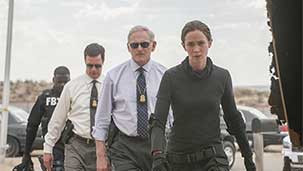Dear Fellow Film Critics,
I’ll spare you my usual end-of-year trepidation about critical subjectivity and ethical dilemmas and simply say this: there was only one movie in 2015 that thrilled me to the point of physical response—had me grinning, and clapping my hands, and clenching my fists, and holding my breath. You may be surprised to know that it wasn’t Mad Max: Fury Road (just like I was surprised that it wasn’t The Force Awakens).
No, the movie that sent me into gleeful paroxysms was, in fact, a gloomy action-thriller about the moral frivolousness of the war on drugs.
I can’t argue that there’s anything terribly original about Sicario. From the structure of its plot to the politics of its themes, it’s basically a mash-up of stuff we’ve seen before. A pretty brilliant mash-up, to be fair—of two classic films, in particular: Steven Soderbergh’s 2000 drug epic Traffic, and the seminal profilers-hunting-serial-killers flick The Silence of the Lambs.
What makes it special, then? What is the one thing Sicario did better than any other movie?
Simply put: it was the most masterful display of filmmaking I saw all year.
In a year notable for action-picture self-indulgence (the final act of Jurassic World seemed lifted from the climax of some long ago Wrestlemania, and, for all its virtues, Mad Max: Fury Road is less interested in restraint than it is in making its complete lack of restraint as efficient as possible) Sicario is a tense, exciting film that finds tension and excitement in the smallest, quietest moments. Better than any other film, it uses the unique virtues of the art form to tell a story, provoke thought, stoke emotion, wring sweat, punch guts.
It begins and ends with director Denis Villeneuve. Such care is taken with the way the narrative unfolds that you can’t help but be amazed by how simple he makes it seem. Scene by scene, moment by moment—there’s not a wasted frame, or line of dialogue, or sound effect, or shadow, or mote of dust on the lens. None of it is superfluous, it all contributes to the experience. This attention to detail in the construction of each scene pays incredible dividends. A convoy of trucks passing over the Mexican border makes for perhaps the most tense scene in the entire film—and perhaps in the entire year of film. No chase, no stunts—all they’re doing is driving. For me, that sequence was more viscerally exciting than any of the practical stunts in Fury Road, more anxiety-inducing than watching Matt Damon try to duct-tape his facemask back together in The Martian (I mean, you know he’s going to—there’s still another hour of the movie left).
Later, during an interrogation, a character far in the background leaves the room, and, as he does, subtly flips the switch on a camcorder. Such dread is generated by that small gesture that there is no need to see what happens next, you know it’s going to be terrible. Villeneuve knows this and smartly cuts away. That kind of confidence in a filmmaker exhilarating.
Still later, when a romantic tryst takes an unexpected turn, Villeneuve once again refuses to take the easy route; there’s no big surprise, no attempt to shock—instead we share a drawn-out moment of recognition with the protagonist, an FBI agent played by Emily Blunt, as she notices an object sitting in the foreground. We share her confusion, too, as she tries to process exactly what it means. What could easily have been expressed with a stab of music or a smash cut is instead drawn out over the course of ninety agonizing seconds, and concludes with one of those satisfying movie moments that is not quite unexpected but wonderfully fulfilling when elegantly executed. And this film is nothing if not elegant in its execution.
David Mamet described the essential task of the dramatist as striking a balance between withholding and vouchsafing information. This isn’t just a principle that Villeneuve exhibits in his filmmaking; it’s also a pretty accurate plot description of Sicario. Blunt is recruited to join a special-ops task force that she knows virtually nothing about, and, over the course of the film, during briefings and missions and personal encounters, learns the real (and disturbing) mandate of the operation. Information is gradually revealed, the story blooms orchid-like. But while I admired the cleverness of the scene construction throughout, it was never from a distance. Villeneuve puts you inside the car, inside the tunnels, inside Blunt’s head as she struggles to put together the puzzle—the same puzzle we are.
Blunt is terrific, by the way, forgoing all the tough-chick posturing that so many actresses might have brought to the role. She speaks plainly, refuses to be intimidated, stands up for her values, shoots bad guys, but never has to act masculine to demonstrate her competence. What is lovely about her character – and what makes her very different than Clarice Starling in The Silence of the Lambs, that other young female law enforcement agent drawn into a cat-and-mouse game between opposing forces of good and evil – is that she very well could have be a man. Her gender is secondary to all the other traits – her honesty, her curiosity, her incorruptibility – that make her the moral center of the film. For the sake of brevity, I’ll withhold praise for her co-stars Del Toro and Brolin, who each deserve seven or eight paragraphs of adulation and flattery, playing tough guys without ever playing tough, chewing just enough scenery to satisfy our appetites, leaving enough behind that they maintain their humanity (Brolin’s character, in particular, could have been played like a cartoon, but isn’t, and watching him walk that precarious line is one of the thousand small thrills of this film).
And if that wasn’t enough. Sicario is also the most beautiful film of the year, which means, yes, of course, that it was shot by Roger Deakins, who shall heretofore be referred to as The Great Roger Deakins, and who has become, for me, one of those contributors whose name in the credits makes a film worth seeing; he is, to date, the only cinematographer whose IMDB page I have visited in desperate anticipation of his next flick (for all my fellow GRDites out there, it’s the Coen Brothers’ Hail Caesar!).
Even the most incompetent Instagram photographer can capture a half-decent sunset, but Deakins manages, late in the film, to shoot a sunset that will make you feel like you’ve never seen a sunset before.
Many of you were disappointed by the third act, and, to be honest, I get where you’re coming from. We spend so much of the film seeing this world through Blunt’s eyes (as Tim McEown nicely explains in his review) that the sudden shift in perspective is, admittedly, jarring. But it makes such perfect narrative sense that I can’t imagine the film ending any other way: the curtain is finally drawn back, we see the gruesome truth that Blunt has unknowingly been party to, and for that truth to have any real impact we need to see the consequences. Not hear about them in expositional dialogue, not be spared the horror. We have to see it. And nothing in cinema this year will elate your lizard-brain and crush your moral consciousness like that moment.
What I want most from watching a film is to feel it. For it to be an experience. I want to be moved from one place to another during the course of those two precious hours – intellectually, emotionally, even physically – and film, as a medium, is able to compel this movement in some very special ways.
Sicario moved me, and that’s why, for me, it was the best film of the year.
Sincerely,

Jared




